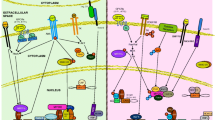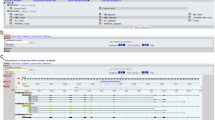Abstract
Smooth muscle cells (SMCs) are key components of all hollow organs, where they perform contractile, synthetic and other functions. Unlike other muscle cells, SMCs are not terminally differentiated, but exhibit considerable phenotypic variation. Such variation is manifested both across disease states such as asthma and atherosclerosis, and physiological states such as pregnancy and wound healing. While there has been considerable investigation into the diversity of SMCs at the level of morphology and individual biomarkers, less is known about the diversity of SMCs at the level of the transcriptome. To explore this question, we performed an extensive statistical analysis that integrates 200 transcriptional profiles obtained in different SMC phenotypes and reference tissues. Our results point towards a non-trivial hypothesis: that transcriptional variation in different SMC phenotypes is characterized by coordinated differential expression of two mutually exclusive (anti-correlating) gene modules. The first of these modules (C) encodes 19 co-transcribed cell cycle associated genes, whereas the other module (E) encodes 41 co-transcribed extra-cellular matrix components. We propose that the positioning of smooth muscle cells along the C/E axis constitutes an important determinant of SMC phenotypes. In conclusion, our study introduces a new approach to assess phenotypic variation in smooth muscle cells, and is relevant as an example of how integrative bioinformatics analysis can shed light on not only terminal differentiated states but also subtler details in phenotypic variability. It also raises the broader question whether coordinated expression of gene modules is a common mechanism underlying phenotypic variability in mammalian cells.




Similar content being viewed by others
References
Anderson JP et al (2004) HRC is a direct transcriptional target of MEF2 during cardiac, skeletal, and arterial smooth muscle development in vivo. Mol Cell Biol 24:3757–3768
Belknap J, Grieshaber N, Schwarz P, Orton E, Reidy M, Majack R (1996) Tropoelastin gene expression in individual vascular smooth muscle cells. Relationship to DNA synthesis during vascular development and after arterial injury. Circ Res 78:388–394
Belknap JK, Weiser-Evans MC, Grieshaber SS, Majack RA, Stenmark KR (1999) Relationship between perlecan and tropoelastin gene expression and cell replication in the developing rat pulmonary vasculature. Am J Respir Cell Mol Biol 20:24–34
Berk BC (2001) Vascular smooth muscle growth: autocrine growth mechanisms. Physiol Rev 81:999–1030
Brand-Saberi B (2005) Genetic and epigenetic control of skeletal muscle development. Ann Anat 187:199–207
Breuiller-Fouche M, Germain G (2006) Gene and protein expression in the myometrium in pregnancy and labor. Reproduction 131:837–850
Breuiller-Fouche M, Charpigny G, Germain G (2007) Functional genomics of the pregnant uterus: from expectations to reality, a compilation of studies in the myometrium. BMC Pregnancy Childbirth 7 Suppl 1:S4
Buxton IL (2004) Regulation of uterine function: a biochemical conundrum in the regulation of smooth muscle relaxation. Mol Pharmacol 65:1051–1059
Chamley-Campbell J, Campbell G, Ross R (1981) Phenotype-dependent response of cultured aortic smooth muscle to serum mitogens. J Cell Biol 89(2):379–383
Chaponnier C, Gabbiani G (2004) Pathological situations characterized by altered actin isoform expression. J Pathol 204:386–395
Cripps RM, Olson EN (2002) Control of cardiac development by an evolutionarily conserved transcriptional network. Dev Biol 246:14–28
Davidson EH (2001) Genomic regulatory systems. Development and evolution. Academic Press, New York
Desmouliere A, Guyot C, Gabbiani G (2004) The stroma reaction myofibroblast: a key player in the control of tumor cell behavior. Int J Dev Biol 48:509–517
Elias JA, Zhu Z, Chupp G, Homer RJ (1999) Airway remodeling in asthma. J Clin Invest 104:1001–1006
Everett L, Wang LS, Hannenhalli S (2006) Dense subgraph computation via stochastic search: application to detect transcriptional modules. Bioinformatics 22:e117–e123
Farmer SR (2006) Transcriptional control of adipocyte formation. Cell Metab 4:263–273
Furlong EE (2004) Integrating transcriptional and signalling networks during muscle development. Curr Opin Genet Dev 14:343–350
Gabbiani G, Ryan GB, Majne G (1971) Presence of modified fibroblasts in granulation tissue and their possible role in wound contraction. Experientia 27:549–550
Grotendorst GR, Rahmanie H, Duncan MR (2004) Combinatorial signaling pathways determine fibroblast proliferation and myofibroblast differentiation. FASEB J 18:469–479
Guyton AC, Hall JE (2005) Textbook of medical physiology, 11th edn. W. B. Saunders, Philadelphia
Hofmann CS et al (2005) B-Myb represses elastin gene expression in aortic smooth muscle cells. J Biol Chem 280:7694–7701
Hogemann B, Gillessen A, Bocker W, Rauterberg J, Domschke W (1993) Myofibroblast-like cells produce mRNA for type I and III procollagens in chronic active hepatitis. Scand J Gastroenterol 28:591–594
Johnson RJ et al (1991) Expression of smooth muscle cell phenotype by rat mesangial cells in immune complex nephritis. Alpha-smooth muscle actin is a marker of mesangial cell proliferation. J Clin Invest 87:847–858
Kapanci Y, Burgan S, Pietra GG, Conne B, Gabbiani G (1990) Modulation of actin isoform expression in alveolar myofibroblasts (contractile interstitial cells) during pulmonary hypertension. Am J Pathol 136:881–889
Karnik SK et al (2003) A critical role for elastin signaling in vascular morphogenesis and disease. Development 130:411–423
Kelleher CM, McLean SE, Mecham RP (2004) Vascular extracellular matrix and aortic development. Curr Top Dev Biol 62:153–188
King RD et al (2004) Functional genomic hypothesis generation and experimentation by a robot scientist. Nature 427:247–252
King JY et al (2005) Pathway analysis of coronary atherosclerosis. Physiol Genomics 23:103–118
Kumar MS, Owens GK (2003) Combinatorial control of smooth muscle-specific gene expression. Arterioscler Thromb Vasc Biol 23:737–747
Lahdesmaki H, Shmulevich L, Dunmire V, Yli-Harja O, Zhang W (2005) In silico microdissection of microarray data from heterogeneous cell populations. BMC Bioinformatics 6:54
Lamb J et al (2006) The connectivity map: using gene-expression signatures to connect small molecules, genes, and disease. Science 313:1929–1935
Layne MD et al (2002) Characterization of the mouse aortic carboxypeptidase-like protein promoter reveals activity in differentiated and dedifferentiated vascular smooth muscle cells. Circ Res 90:728–736
Li H et al (2006) Integrative genetic analysis of transcription modules: towards filling the gap between genetic loci and inherited traits. Hum Mol Genet 15:481–492
Li JM et al (2007) Temporal evolution of gene expression in rat carotid artery following balloon angioplasty. J Cell Biochem 101:399–410
Majesky MW (2002) Smooth muscle-specific transcription without a CArG box element. Circ Res 90:628–630
Marhamati DJ, Sonenshein GE (1996) B-Myb expression in vascular smooth muscle cells occurs in a cell cycle-dependent fashion and down-regulates promoter activity of type I collagen genes. J Biol Chem 271:3359–3365
McLean SE, Mecham BH, Kelleher CM, Mariani TJ, Mecham RP (2005) Extracellular matrix gene expression in the developing mouse aorta. Adv Dev Biol 15:82–128
Meyer T, Brink U, Unterberg C, Stohr S, Kreuzer H, Buchwald AB (1994) Expression of meta-vinculin in human coronary arteriosclerosis is related to the histological grade of plaque formation. Atherosclerosis 111:111–119
Miano JM (2002) Mammalian smooth muscle differentiation: origins, markers and transcriptional control. Results Probl Cell Differ 38:39–59
Miano JM, Long X, Fujiwara K (2007) Serum response factor: master regulator of the actin cytoskeleton and contractile apparatus. Am J Physiol Cell Physiol 292:C70–C81
Nelander S (2005) A genomic approach to smooth muscle differentiation and diversity. In: institute of medical biochemisty. Göteborg University, Göteborg
Nelander S, Mostad P, Lindahl P (2003) Prediction of cell type-specific gene modules: identification and initial characterization of a core set of smooth muscle-specific genes. Genome Res 13:1838–1854
Nelander S et al (2005) Predictive screening for regulators of conserved functional gene modules (gene batteries) in mammals. BMC Genomics 6:68
Owens GK, Kumar MS, Wamhoff BR (2004) Molecular regulation of vascular smooth muscle cell differentiation in development and disease. Physiol Rev 84:767–801
Papallo A (2005) A Compendium of Microarrays for Normal Human Cell Cultures (Gene Expression Omnibus database entry GSE3239, http://ncbi.nlm.nih.gov/geo). In: Gene Expression Omnibus
Rehman KS, Yin S, Mayhew BA, Word RA, Rainey WE (2003) Human myometrial adaptation to pregnancy: cDNA microarray gene expression profiling of myometrium from non-pregnant and pregnant women. Mol Hum Reprod 9:681–700
Schwartz SM, Majesky MW, Murry CE (1995) The intima: development and monoclonal responses to injury. Atherosclerosis 118 Suppl:S125–S140
Segal E, Friedman N, Koller D, Regev A (2004) A module map showing conditional activity of expression modules in cancer. Nat Genet 36:1090–1098
Smith E, Sigvardsson M (2004) The roles of transcription factors in B lymphocyte commitment, development, and transformation. J Leukoc Biol 75:973–981
Su AI et al (2004) A gene atlas of the mouse and human protein-encoding transcriptomes. Proc Natl Acad Sci USA 101:6062–6067
Tanay A, Regev A, Shamir R (2005) Conservation and evolvability in regulatory networks: the evolution of ribosomal regulation in yeast. Proc Natl Acad Sci USA 102:7203–7208
Tegner J, Yeung MK, Hasty J, Collins JJ (2003) Reverse engineering gene networks: integrating genetic perturbations with dynamical modeling. Proc Natl Acad Sci USA 100:5944–5949
Thomas AC, Campbell JH (2000) Contractile and cytoskeletal proteins of smooth muscle cells in rat, rabbit, and human arteries. Tissue Cell 32:249–256
Wachi H, Seyama Y, Yamashita S, Tajima S (1995) Cell cycle-dependent regulation of elastin gene in cultured chick vascular smooth-muscle cells. Biochem J 309:575–579
Wang DZ, Olson EN (2004) Control of smooth muscle development by the myocardin family of transcriptional coactivators. Curr Opin Genet Dev 14:558–566
Wang M, Master SR, Chodosh LA (2006) Computational expression deconvolution in a complex mammalian organ. BMC Bioinformatics 7:328
Wasserman WW, Sandelin A (2004) Applied bioinformatics for the identification of regulatory elements. Nat Rev Genet 5:276–287
Weiser MC, Belknap JK, Grieshaber SS, Kinsella MG, Majack RA (1996) Developmental regulation of perlecan gene expression in aortic smooth muscle cells. Matrix Biol 15:331–340
Xu X, Wang L, Ding D (2004) Learning module networks from genome-wide location and expression data. FEBS Lett 578:297–304
Acknowledgments
We thank Björn Nilsson and Nikolaus Schultz for reading and commenting on the manuscript. Support from SWEGENE, the EMBO fellowship program and the Swedish Royal Academy of Sciences’ Lindahl award made the research possible.
Author information
Authors and Affiliations
Corresponding author
Additional information
Communicated by P. Ruiz.
Rights and permissions
About this article
Cite this article
Larsson, E., McLean, S.E., Mecham, R.P. et al. Do two mutually exclusive gene modules define the phenotypic diversity of mammalian smooth muscle?. Mol Genet Genomics 280, 127–137 (2008). https://doi.org/10.1007/s00438-008-0349-y
Received:
Accepted:
Published:
Issue Date:
DOI: https://doi.org/10.1007/s00438-008-0349-y




